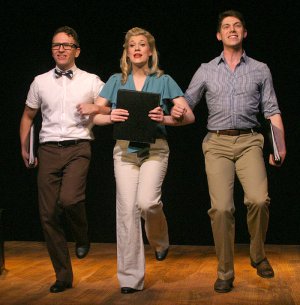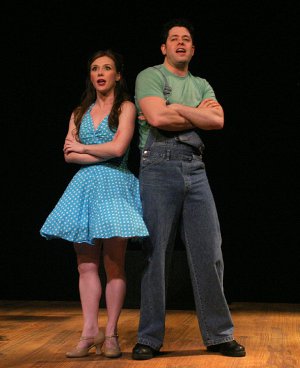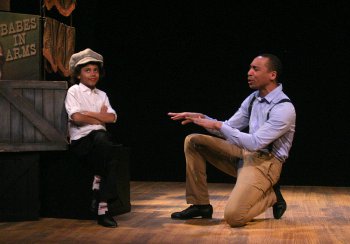Babes in Arms
Lush thirties musical with the most Rodgers and Hart hits of any of their shows proves to be both prescient and timely again.

Courter Simmons, Lauren Nicole Chapman and Justin Schuman in a scene from Musicals Tonight!’s revival of Rodgers & Hart’s “Babes in Arms” (Photo credit: Michael Portantiere)
[avatar user=”Victor Gluck” size=”96″ align=”left” ] Victor Gluck, Editor-in-Chief[/avatar]Rodgers & Hart’s 1937 Babes in Arms is decidedly a depression era musical, but with its talk of racism, feminism, democracy, socialism, and poverty the show turns out to be both prescient and timely again. The Musicals Tonight! revival of the classic show with book, music and lyrics by the duo themselves in the John Guare revisal created for the 1999 Encores! Production has been given a sharp, fast-paced, animated production by director/choreographer Keith Andrews in which all of the jokes land with a zing. The large cast of 19 talented singers and dancers is made up of mostly unfamiliar faces – just like the original production which saw the Broadway debuts of Alfred Drake, Dan Dailey and Mitzi Green.
The musical known for its “Let’s put on a show!” plot has a great deal more going for it than one might expect. First off, it has one of the greatest scores ever written for a Broadway musical comedy adding the witty and lilting “Where or When,” “I Wish I Were in Love Again,” “Way Out West (on West End Avenue),” “Johnny One Note,” “The Lady Is A Tramp,” “Imagine” and the title number to the American Songbook. This represented more hits than any other R&H show. The political plot (which was sanitized in 1959 under the auspices of the composer himself) has been restored and the show is positively electric with hotly debated ideas, philosophies and theories. As performed by Andrews’ cast, the satiric show has a colorful array of dynamic characters.
In the artist colony of Seaport, Long Island, the parents of a group of teenagers leave to travel the vaudeville circuit and earn some cash at the height of the Depression – even though everyone knows that Vaudeville as an art form is dead. Unfortunately, they have left them with no money, planning on sending checks from the road when they get paid. Fearing that with nothing to do the kids will cause him trouble, Sheriff Reynolds threatens to send them to the work farm. Plucky Valentine LaMar, who believes in the democratic system and free will organizes the kids to put on a show. He is joined by his best friend and law student Marshall Blackstone, Billie Smith (the new gal just back from a jaunt to become a movie star in Hollywood), and pugnacious Gus Fielding (who believes that might makes right).

Lilly Tobin and Casey Shine in Musicals Tonight!’s revival of Rodgers & Hart’s “Babes in Arms” (Photo credit: Michael Portantiere)
Their numbers are augmented by friends and neighbors Peter who believes in socialist principles, two extraordinary Black tap dancers, the de Quincys (originally played by the Nicholas Brothers), Baby Rose (a former Hollywood star now retired since the age of seven) and Dolores, the sheriff’s flirtatious daughter. However, first they have to round up the money from the local lord of the manor Lee Calhoun, son of a rich Southern colonel, who makes no bones about his being an outright racist. After a great many misadventures including the crash of a famous French aviator on a field owned by Val’s parents, plus assorted romantic entanglements, it all works out happily for the youth of Seaport. The many topical references of the period that still resonate include FDR, Mayor La Guardia, Karl Marx, and Walter Winchell.
Director Andrews has taught his cast how to sell a song, and sell they do with dance moves, acting chops, and appropriate gestures, rather than the usual way of singers standing still and looking into each other’s eyes. As the hero and heroine, Val and Billie, stalwart Justin Schuman and vivacious Lauren Nicole Chapman make beautiful music together with lovely renditions of “Where or When” and “All at Once,” while Chapman commands the stage with a potent version of “The Lady is a Tramp,” (that is, a free thinking liberal).
As the secondary love interest, blonde Lilly Tobin and muscular Casey Shine as flirtatious Dolores and hot-tempered Gus strike sparks as they perform “I Wish I Were in Love Again” and “You Are So Fair.” As Baby Rose, Tessa Faye’s big brassy renditions of “Johnny One Note” and “Imagine” put one in mind of Ethel Merman – though she would have been all wrong as the former child star. Sebastian Maynard-Palmer and Neville Braithwaite as the de Quincy Brothers do a mean tap-dance, not once but several times. As the repugnant Lee Calhoun, Perry Sook makes him as unctuous and unpleasant as he is supposed to be.

Sebastian Maynard-Palmer and Neville Braithwaite in a scene from Musicals Tonight!’s revival of Rodgers & Hart’s “Babes in Arms” (Photo credit: Michael Portantiere)
As choreographer, Andrews acquits himself well with the clever full-length “Peter’s Journey Ballet.” Kudos to music director and vocal arranger James Stenborg for his sprightly accompaniment of the entire score which pours richly from the on stage piano. Courtney Megaro’s lighting design undergoes subtle changes during the musical numbers. The uncredited costumes go a long way to suggesting the era when the show was written. If one hasn’t heard Lorenz Hart’s lyrics lately, it is possible to have forgotten what a master of wit and style he was (his invention of oft-quoted “hobohemia” appears in one of these lyrics), while we can never forget what a melodist Richard Rodgers was at all times.
While they don’t write them this way anymore – and they probably shouldn’t – Musical Tonight!’s revival of Babes in Arms with its debates about political systems puts one in mind of the current crop of political headliners (Donald Trump, Bernie Sanders, Hilary Clinton, Chris Christie, Bill de Blasio) and proves that everything old is new again.
Babes in Arms (through March 20, 2016)
Musicals Tonight!
The Lion Theatre on Theatre Row, 410 W. 42nd Street, in Manhattan
For tickets, call 212-239-6200 or visit http://www.musicalstonight.org
Running time: two hours and 15 minute with one intermission






Leave a comment